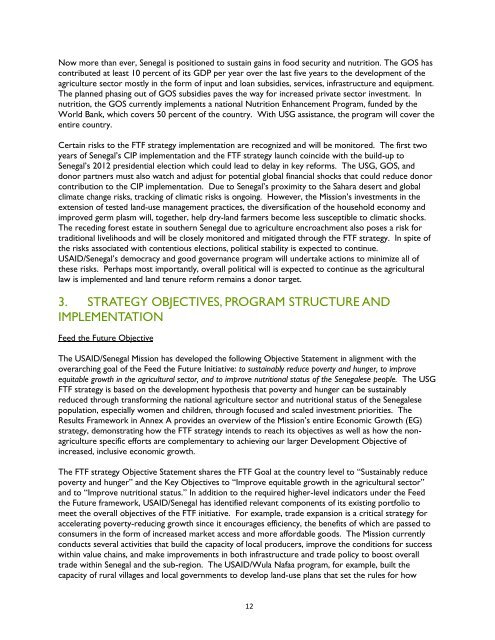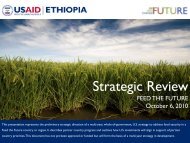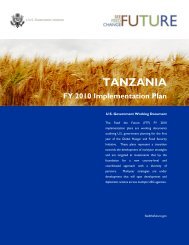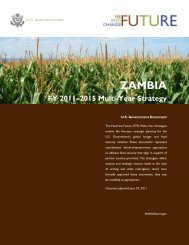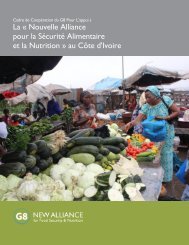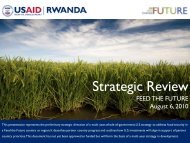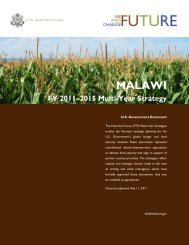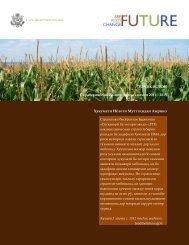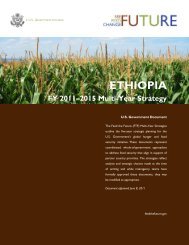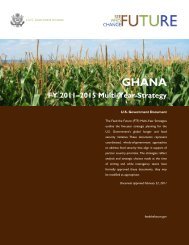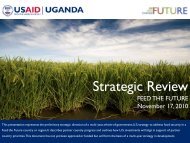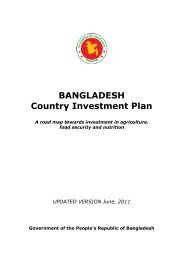Feed the Future Multi-Year Strategy, Senegal, Public
Feed the Future Multi-Year Strategy, Senegal, Public
Feed the Future Multi-Year Strategy, Senegal, Public
Create successful ePaper yourself
Turn your PDF publications into a flip-book with our unique Google optimized e-Paper software.
Now more than ever, <strong>Senegal</strong> is positioned to sustain gains in food security and nutrition. The GOS has<br />
contributed at least 10 percent of its GDP per year over <strong>the</strong> last five years to <strong>the</strong> development of <strong>the</strong><br />
agriculture sector mostly in <strong>the</strong> form of input and loan subsidies, services, infrastructure and equipment.<br />
The planned phasing out of GOS subsidies paves <strong>the</strong> way for increased private sector investment. In<br />
nutrition, <strong>the</strong> GOS currently implements a national Nutrition Enhancement Program, funded by <strong>the</strong><br />
World Bank, which covers 50 percent of <strong>the</strong> country. With USG assistance, <strong>the</strong> program will cover <strong>the</strong><br />
entire country.<br />
Certain risks to <strong>the</strong> FTF strategy implementation are recognized and will be monitored. The first two<br />
years of <strong>Senegal</strong>’s CIP implementation and <strong>the</strong> FTF strategy launch coincide with <strong>the</strong> build-up to<br />
<strong>Senegal</strong>’s 2012 presidential election which could lead to delay in key reforms. The USG, GOS, and<br />
donor partners must also watch and adjust for potential global financial shocks that could reduce donor<br />
contribution to <strong>the</strong> CIP implementation. Due to <strong>Senegal</strong>’s proximity to <strong>the</strong> Sahara desert and global<br />
climate change risks, tracking of climatic risks is ongoing. However, <strong>the</strong> Mission’s investments in <strong>the</strong><br />
extension of tested land-use management practices, <strong>the</strong> diversification of <strong>the</strong> household economy and<br />
improved germ plasm will, toge<strong>the</strong>r, help dry-land farmers become less susceptible to climatic shocks.<br />
The receding forest estate in sou<strong>the</strong>rn <strong>Senegal</strong> due to agriculture encroachment also poses a risk for<br />
traditional livelihoods and will be closely monitored and mitigated through <strong>the</strong> FTF strategy. In spite of<br />
<strong>the</strong> risks associated with contentious elections, political stability is expected to continue.<br />
USAID/<strong>Senegal</strong>’s democracy and good governance program will undertake actions to minimize all of<br />
<strong>the</strong>se risks. Perhaps most importantly, overall political will is expected to continue as <strong>the</strong> agricultural<br />
law is implemented and land tenure reform remains a donor target.<br />
3. STRATEGY OBJECTIVES, PROGRAM STRUCTURE AND<br />
IMPLEMENTATION<br />
<strong>Feed</strong> <strong>the</strong> <strong>Future</strong> Objective<br />
The USAID/<strong>Senegal</strong> Mission has developed <strong>the</strong> following Objective Statement in alignment with <strong>the</strong><br />
overarching goal of <strong>the</strong> <strong>Feed</strong> <strong>the</strong> <strong>Future</strong> Initiative: to sustainably reduce poverty and hunger, to improve<br />
equitable growth in <strong>the</strong> agricultural sector, and to improve nutritional status of <strong>the</strong> <strong>Senegal</strong>ese people. The USG<br />
FTF strategy is based on <strong>the</strong> development hypo<strong>the</strong>sis that poverty and hunger can be sustainably<br />
reduced through transforming <strong>the</strong> national agriculture sector and nutritional status of <strong>the</strong> <strong>Senegal</strong>ese<br />
population, especially women and children, through focused and scaled investment priorities. The<br />
Results Framework in Annex A provides an overview of <strong>the</strong> Mission’s entire Economic Growth (EG)<br />
strategy, demonstrating how <strong>the</strong> FTF strategy intends to reach its objectives as well as how <strong>the</strong> nonagriculture<br />
specific efforts are complementary to achieving our larger Development Objective of<br />
increased, inclusive economic growth.<br />
The FTF strategy Objective Statement shares <strong>the</strong> FTF Goal at <strong>the</strong> country level to “Sustainably reduce<br />
poverty and hunger” and <strong>the</strong> Key Objectives to “Improve equitable growth in <strong>the</strong> agricultural sector”<br />
and to “Improve nutritional status.” In addition to <strong>the</strong> required higher-level indicators under <strong>the</strong> <strong>Feed</strong><br />
<strong>the</strong> <strong>Future</strong> framework, USAID/<strong>Senegal</strong> has identified relevant components of its existing portfolio to<br />
meet <strong>the</strong> overall objectives of <strong>the</strong> FTF initiative. For example, trade expansion is a critical strategy for<br />
accelerating poverty-reducing growth since it encourages efficiency, <strong>the</strong> benefits of which are passed to<br />
consumers in <strong>the</strong> form of increased market access and more affordable goods. The Mission currently<br />
conducts several activities that build <strong>the</strong> capacity of local producers, improve <strong>the</strong> conditions for success<br />
within value chains, and make improvements in both infrastructure and trade policy to boost overall<br />
trade within <strong>Senegal</strong> and <strong>the</strong> sub-region. The USAID/Wula Nafaa program, for example, built <strong>the</strong><br />
capacity of rural villages and local governments to develop land-use plans that set <strong>the</strong> rules for how<br />
12


